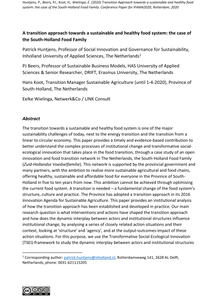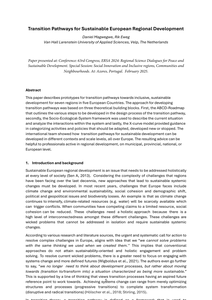Global climate agreements call for action and an integrated perspective on mobility, energy and overall consumption. Municipalities in dense, urban areas are challenged with facilitating this transition with limited space and energy resources, and with future uncertainties. One important aspect of the transition is the adoption of electric vehicles, which includes the adequate design of charging infrastructure. Another important goal is a modal shift in transportation. This study investigated over 80 urban mobility policy measures that are in the policy roadmap of two of the largest municipalities of the Netherlands. This analysis consists of an inventory of policy measures, an evaluation of their environmental effects and conceptualizations of the policy objectives and conditions within the mobility transitions. The findings reveal that the two municipalities have similarities in means, there is still little anticipation of future technology and policy conditions could be further satisfied by introducing tailored measures for specific user groups.
DOCUMENT

Mobility hubs facilitate multimodal transport and have the potential to improve the accessibility and usability of new mobility services. However, in the context of increasing digitalisation, using mobility hubs requires digital literacy or even owning a smartphone. This constraint may result in the exclusion of current and potential users. Digital kiosks might prove to be a solution, as they can facilitate the use of the services found at mobility hubs. Nevertheless, knowledge of how digital kiosks may improve the experience of disadvantaged groups remains limited in the literature. As part of the SmartHubs project, a field test with a digital kiosk was conducted with 105 participants in Brussels (Belgium) and Rotterdam (The Netherlands) to investigate the intention to use it and its usability in the context of mobility hubs. This study adopted a mixed methods approach, combining participant observation and questionnaire surveys. Firstly, participants were asked to accomplish seven tasks with the digital kiosk while being observed by the researchers. Finally, assisted questionnaire surveys were conducted with the same participants, including close-ended, open-ended and socio-demographic questions. The results offer insights into the experience of the users of a digital kiosk in a mobility hub and the differences across specific social groups. These findings may be relevant for decision-makers and practitioners working in urban mobility on subjects such as mobility hubs and shared mobility, and for user interface developers concerned with the inclusivity of digital kiosks.
LINK
DOCUMENT

The transition towards a sustainable and healthy food system is one of the major sustainability challenges of today, next to the energy transition and the transition from a linear to circular economy. This paper provides a timely and evidence-based contribution to better understand the complex processes of institutional change and transformative social-ecological innovation that takes place in the food transition, through a case study of an open innovation and food transition network in The Netherlands, the South-Holland Food Family (Zuid-Hollandse Voedselfamilie). This network is supported by the provincial government and many partners, with the ambition to realize more sustainable agricultural and food chains, offering healthy, sustainable and affordable food for everyone in the Province of South-Holland in five to ten years from now. This ambition cannot be achieved through optimising the current food system. A transition is needed – a fundamental change of the food system’s structure, culture and practice. The Province has adopted a transition approach in its 2016 Innovation Agenda for Sustainable Agriculture. This paper provides an institutional analysis of how the transition approach has been established and developed in practice. Our main research question is what interventions and actions have shaped the transition approach and how does the dynamic interplay between actors and institutional structures influence institutional change, by analysing a series of closely related action situations and their context, looking at 'structure' and 'agency', and at the output-outcomes-impact of these action situations. For this purpose, we use the Transformative Social-Ecological Innovation (TSEI)-framework to study the dynamic interplay between actors and institutional structures influencing institutional change. The example of TSEI-framework application in this paper shows when and how local agents change the institutional context itself, which provides relevant insights on institutional work and the mutually constitutive nature of structure and agency. Above institutional analysis also shows the pivotal role of a number of actors, such as network facilitators and provincial minister, and their capability and skills to combine formal and informal institutional environments and logics and mobilize resources, thereby legitimizing and supporting the change effort. The results are indicative of the importance of institutional structures as both facilitating (i.e., the province’s policies) and limiting (e.g. land ownership) transition dynamics.
DOCUMENT

Abstract The Government of the Netherlands wants to be energy neutral by 2050 (Rijksoverheid, sd). A transition towards non-fossil energy sources also affects transport, which is one of the industries significantly contributing to CO2 emission (Centraal Bureau Statistiek, 2019). Road authorities at municipalities and provinces want a shift from fossil fuel-consuming to zero-emission transport choices by their inhabitants. For this the Province of Utrecht has data available. However, they struggle how to deploy data to positively influence inhabitants' mobility behavior. A problem analysis scoped the research and a survey revealed the gap between the province's current data-item approach that is infrastructure oriented and the required approach that adopts traveler’s personas to successfully stimulate cycling. For this more precisely defined captured data is needed and the focus should shift from already motivated cyclists to non-cyclers.
DOCUMENT

This paper describes prototypes for transition pathways towards inclusive, sustainable development for seven regions in five European Countries. The approach for developing transition pathways was based on three theoretical building blocks. First, the ABCD-Roadmap that outlines the various steps to be developed in the design process of the transition pathway, secondly, the Socio-Ecological-System framework was used to describe the current situation and analyze the interactions within the system and lastly, the X-curve model provided guidance in categorizing activities and policies that should be adapted, developed new or stopped. The international team showed how transition pathways for sustainable development can be developed in different contexts and scale levels, all over Europe. The resulting advice can be helpful to professionals active in regional development, on municipal, provincial, national, or European level.
DOCUMENT

Our world is made up of so much technology, all around us, that we are barely aware of it. Technology accommodates our existence, as nature did for our prehistoric ancestors and still does for (most) other organisms. In this series of 3, I examine the tension between technology and nature as the host of life on our planet, from a psychological perspective. New technology does not always provide the solution; for example, the widespread ability to live a contemporary life with rapid mobility over long distances now makes a climate and environmental transition extremely necessary. Many major problems with technology are not technological by nature but natural: more is less, less is more, less prosperity, more well-being! Some major transitions are extremely necessary. It is precisely the right to decent work that could force a turnaround here.
MULTIFILE

Een jongerennetwerk is een plek waar jongeren sociale contacten kunnen opdoen en onderlinge steun krijgen. Ook zorgt commissie- en bestuurswerk voor een groei van hun persoonlijke, professionele vaardigheden. Tijdens de eindconferentie deelde lectoraat Diversiteitsvraagstukken inzichten over hoe de deelname van jongeren aan een netwerk of community bij kan dragen aan het realiseren van hun toekomst. Ze leerden hoe deelname aan een jongerennetwerk bijdraagt aan een positief zelfbeeld, een positieve identiteit en het versterken van ambities. Hierdoor krijgen zij de kracht om vol zelfvertrouwen een plek te vinden binnen de onderwijs- of arbeidsomgeving.
MULTIFILE
